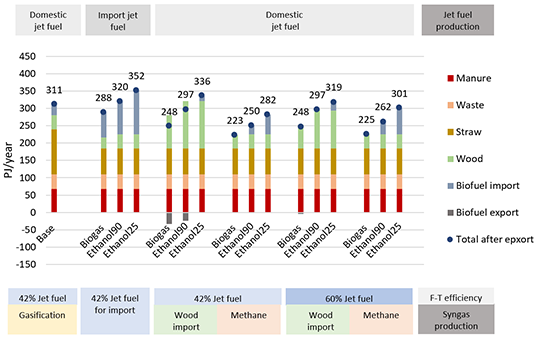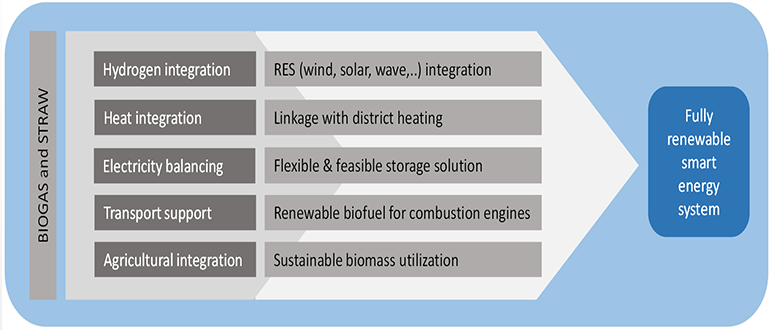Eva Felicitas Vieweg
Master Thesis – Environmental Technology - 2018
Renewable energy sources such as bioenergy fuels, wind and solar power are seminal for developing a fossil energy free society. The main difficulty encountered by the renewable energy system is due to the limitation of the biomass potential, the fluctuation of renewable electricity sources and the lack of sufficient electrical energy distribution options to the consumers.
Biomass is forecasted to become one of the main pillars of the future energy system. The capability of balancing the fluctuation of wind, solar and wave power supports the future role of bioenergy. Biomass can be utilized in an almost identical way to fossil fuels relevant for the transportation sector (Biomass-to-Liquid). The critical issue about the use of biomass for energy production appears to be the food insecurity, the greenhouse gas emissions, the biodiversity loss from the land use and change, and the overuse of water and soil. The biomass resources are limited and must be therefore used in an effectively and energy-saving way.
The report discovers, that the choice of biomass conversion pathway significantly influences the overall Danish energy system performance, inclusive cost, biomass demand and sustainability. The system integration aspects of the biomass conversion technology are important for the feasibility and performance of the technology in the system. Additional, system integration properties of biogas are significant.
The study identifies the system integration aspects of biogas and tests their significance. Biogas upgrade leads to a hydrogen integration int the energy system. And thus, arises the possibility of utilizing the process excess heat from methanation and electrolysers. Methane allows a feasible and flexible storage opportunity and thereby secures and balances electricity grid. The agricultural integration provided by biogas provides a sustainable biomass utilization. Biogas is able to apply to the forecasted co-optimization in the cropping scheme, which aims for a protein extraction from the biomass to supply food and feed. Whereas the left-over biomass is suitable for biogas production. This aspect provides an effective biomass utilization with reduced pressure on agricultural land.
Further, alternative uses of the agricultural straw residues for energy conversion are compared. The return of nutrients to the soil such as nitrogen (N), phosphate (P) and potassium (K) are secured due to the appearance of a digestate from biogas production. Moreover, hard degradable carbon is put back on the field as well to secure the carbon balance in the soil. For other conversion pathways, such as ethanol or combustion a “sustainable” removal of agricultural residues needs to be considered. The share of either 90% or 25% of usable sustainable biomass potential if no carbon is returned to the soil depends on the soil and farm type. The manure biogas support is identified as optimizing aspect of the biogas potential from manure by using straw as a co-substrate.
The identified integration aspects are implemented in an energy system analysis by comparing the conversion technologies of biogas and ethanol. The dependency analysis is based on DEA Wind 2050 scenario published by Danish Energy Agency. Thereby different framework conditions for jet fuel provision in the fully renewable energy system are compared. The results show, that the use of straw for biogas has the highest potential while providing the most feasible supply security and most sustainable biomass use. The results were compared to the different conversion pathways for straw, which were ethanol production and gasification.
The least biomass demanding pathway for straw is the biogas production on contrast to gasification and ethanol production, due to the influence of the identified integration aspects. The secured supply to balance the fluctuating nature of renewable heat and power production due to continuous biogas production is a great advantage. Moreover, the investment for electricity and heat production from gas is the least expensive compared to its competitors. Same applies for the biogas production for transportation fuels.
The report identifies that the biogas conversion pathway for straw has a promising potential for the future Danish energy system.

Figure 1: Biomass demand while utilizing 75PJ straw (PJ/year)
